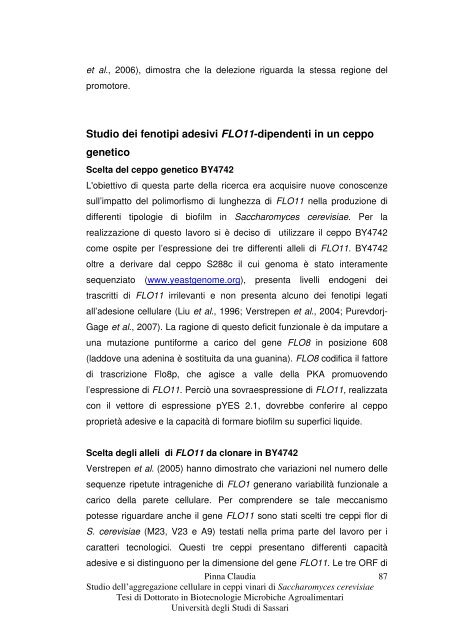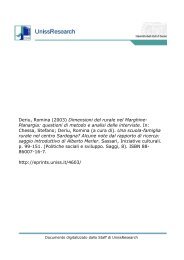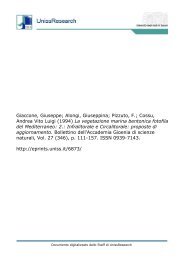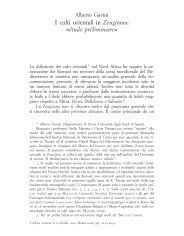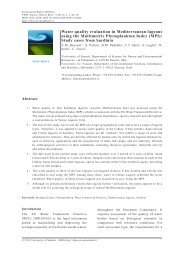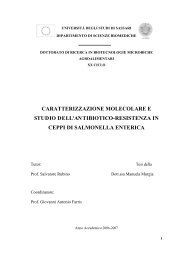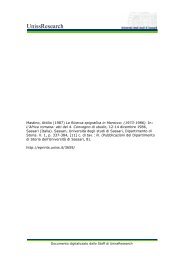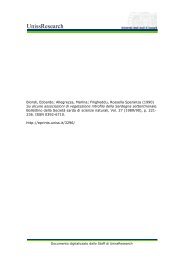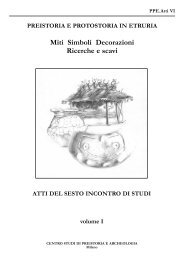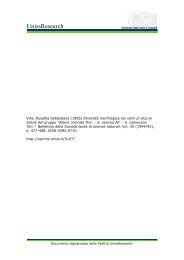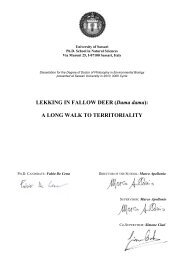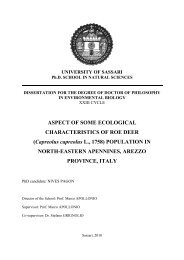Studio dell'aggregazione cellulare in ceppi vinari di Saccharomyces ...
Studio dell'aggregazione cellulare in ceppi vinari di Saccharomyces ...
Studio dell'aggregazione cellulare in ceppi vinari di Saccharomyces ...
Create successful ePaper yourself
Turn your PDF publications into a flip-book with our unique Google optimized e-Paper software.
et al., 2006), <strong>di</strong>mostra che la delezione riguarda la stessa regione del<br />
promotore.<br />
<strong>Stu<strong>di</strong>o</strong> dei fenotipi adesivi FLO11-<strong>di</strong>pendenti <strong>in</strong> un ceppo<br />
genetico<br />
Scelta del ceppo genetico BY4742<br />
L'obiettivo <strong>di</strong> questa parte della ricerca era acquisire nuove conoscenze<br />
sull’impatto del polimorfismo <strong>di</strong> lunghezza <strong>di</strong> FLO11 nella produzione <strong>di</strong><br />
<strong>di</strong>fferenti tipologie <strong>di</strong> biofilm <strong>in</strong> <strong>Saccharomyces</strong> cerevisiae. Per la<br />
realizzazione <strong>di</strong> questo lavoro si è deciso <strong>di</strong> utilizzare il ceppo BY4742<br />
come ospite per l’espressione dei tre <strong>di</strong>fferenti alleli <strong>di</strong> FLO11. BY4742<br />
oltre a derivare dal ceppo S288c il cui genoma è stato <strong>in</strong>teramente<br />
sequenziato (www.yeastgenome.org), presenta livelli endogeni dei<br />
trascritti <strong>di</strong> FLO11 irrilevanti e non presenta alcuno dei fenotipi legati<br />
all’adesione <strong>cellulare</strong> (Liu et al., 1996; Verstrepen et al., 2004; Purevdorj-<br />
Gage et al., 2007). La ragione <strong>di</strong> questo deficit funzionale è da imputare a<br />
una mutazione puntiforme a carico del gene FLO8 <strong>in</strong> posizione 608<br />
(laddove una aden<strong>in</strong>a è sostituita da una guan<strong>in</strong>a). FLO8 co<strong>di</strong>fica il fattore<br />
<strong>di</strong> trascrizione Flo8p, che agisce a valle della PKA promuovendo<br />
l’espressione <strong>di</strong> FLO11. Perciò una sovraespressione <strong>di</strong> FLO11, realizzata<br />
con il vettore <strong>di</strong> espressione pYES 2.1, dovrebbe conferire al ceppo<br />
proprietà adesive e la capacità <strong>di</strong> formare biofilm su superfici liquide.<br />
Scelta degli alleli <strong>di</strong> FLO11 da clonare <strong>in</strong> BY4742<br />
Verstrepen et al. (2005) hanno <strong>di</strong>mostrato che variazioni nel numero delle<br />
sequenze ripetute <strong>in</strong>trageniche <strong>di</strong> FLO1 generano variabilità funzionale a<br />
carico della parete <strong>cellulare</strong>. Per comprendere se tale meccanismo<br />
potesse riguardare anche il gene FLO11 sono stati scelti tre <strong>ceppi</strong> flor <strong>di</strong><br />
S. cerevisiae (M23, V23 e A9) testati nella prima parte del lavoro per i<br />
caratteri tecnologici. Questi tre <strong>ceppi</strong> presentano <strong>di</strong>fferenti capacità<br />
adesive e si <strong>di</strong>st<strong>in</strong>guono per la <strong>di</strong>mensione del gene FLO11. Le tre ORF <strong>di</strong><br />
P<strong>in</strong>na Clau<strong>di</strong>a<br />
<strong>Stu<strong>di</strong>o</strong> dell’aggregazione <strong>cellulare</strong> <strong>in</strong> <strong>ceppi</strong> v<strong>in</strong>ari <strong>di</strong> <strong>Saccharomyces</strong> cerevisiae<br />
Tesi <strong>di</strong> Dottorato <strong>in</strong> Biotecnologie Microbiche Agroalimentari<br />
Università degli Stu<strong>di</strong> <strong>di</strong> Sassari<br />
87


